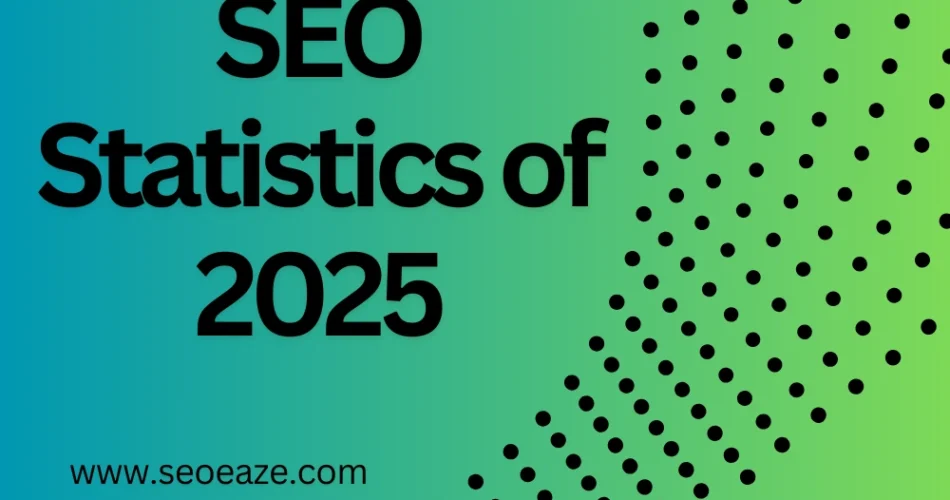Last Updated on January 9, 2025
The year 2025 is significantly different for SEO as generative AI is at its peak, and search engines are overhauling their algorithms. This demands that we provide you with solid SEO statistics which can help you plan your marketing strategy this year.
Here are the 150 SEO statistics that every business should know about SEO in 2025.
Search Engine Market Share & Usage:
In 2025, marketers and businesses need to understand search engines’ market share and usage trends to have reputable online visibility and rank at the top of search engine results. Let’s start with some incredible SEO facts about search engine market.
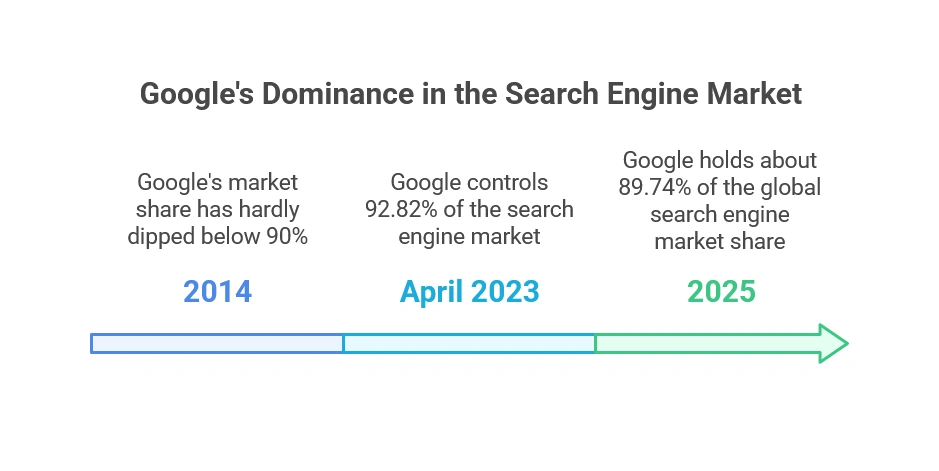
Statistical Facts:
- Google holds about 89.74% of the global search engine market share in 2025 (StatCounter)
- 93 % of all web traffic comes through search engines (source)
- Bing holds about 3.97% of the global search engine market share in 2025 (StatCounter)
- Yahoo processes 63.65 thousand searches per minute, 2.75 billion monthly, and 33 billion yearly (source).
- 45% of the search market is owned by DuckDuckGo (source)
- Google processes 63000 searches per second, 3.8 million per minute, and 2 trillion searches yearly. (source).
- Google holds about 93.68 percent of the mobile search engine market (source).
- Google’s market share has hardly dipped below 90% since 2014 (source).
- The global search engine market is expected to reach 429.8 billion by 2032. (source)
- The size of Google’s search index exceeds over 100 million gigabytes (source).
- The average Google search is 76 seconds long(source)
- Bing processes 121 thousand searches per minute, 2.75 billion searches per month, and 33 billion yearly. (source).
- About 15% of daily search queries on Google are new (source).
- About 45.25% of Google searches are in organic clicks. (source).
- As of April 2023, google controls 92.82% of the search engine market. (source).
- 25% of first-page clicks come from Google searches. (businessdasher.com).
- 77% of people use Google 3 to more times per day. (source)
User search behavior:
User search behavior is how users interact with search engine result pages (SERPS). It also includes how much attention a user pays to a particular SERP and his clicks. A website’s heatmap data can show a user’s behavior and specify where they click, scroll, and tap.
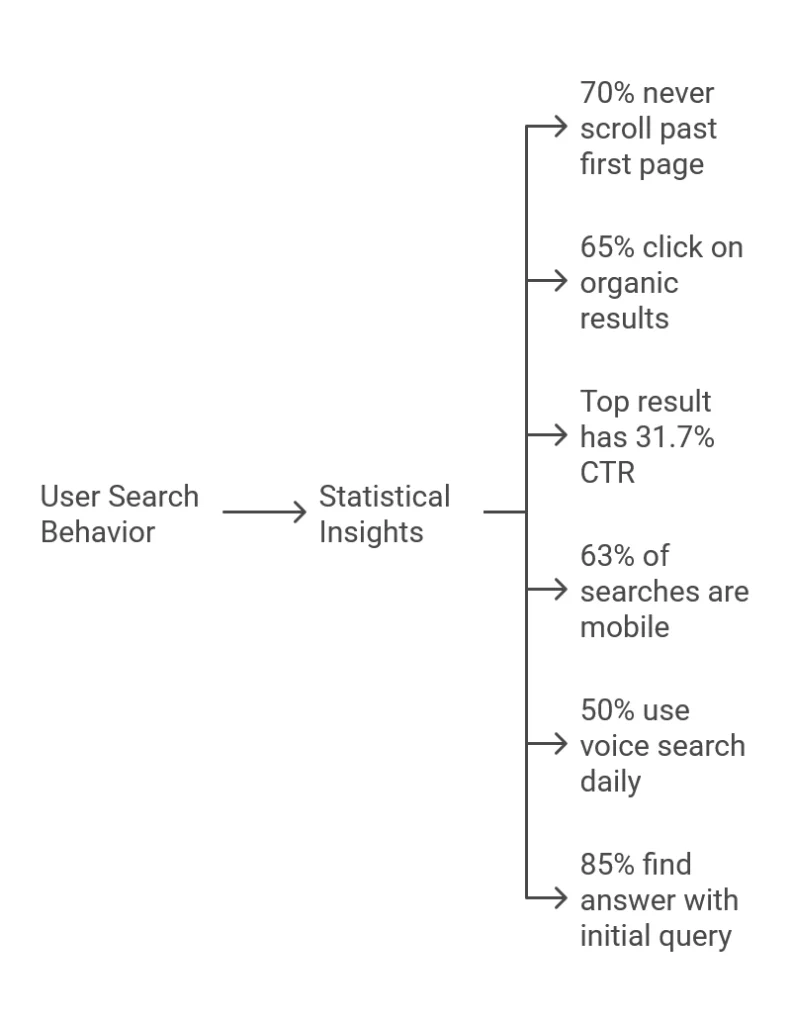
Statistical facts:
- 70% of users never scroll past the first page of search results. (source).
- 65% of Google searchers click on the organic results. (source)
- About 50% of queries contain short phrases of three to four words. (source)
- The top organic result on Google has a click-through rate (CTR) of 31.7%. (source)
- 18% of users search a new query before clicking on any result of their original search (source)
- URLs that contain keywords have a 45% higher CTR than URLs that don’t. (source)
- 63% of Google searches are done on mobile, according to reports in 2024. (source)
- 50% of the United States population uses voice-enabled search daily. (source).
- About 85% of users find an answer to their query with their initial search term. (source)
- On desktops, about 45% of users make decisions in under five seconds of searching, while on mobiles, only 33% can decide what to do next in under five seconds (source).
- Voice searches contain an average of only 29 words. (source)
- On average, a person searches three to four searches daily. (source).
- About 75% of the search queries comprise non-branded keywords. (source).
- Only 9% of users scroll to the bottom of the first page (source)
- 21% of searchers click on more than one search result (source)
- People are using search engines 20% more year-over-year (BrightEdge)
Technical SEO:
Technical SEO is optimizing a website’s technical aspects to increase its ranking in search engine results. For example, fast-loading sites, mobile-friendly websites, and HTTPS websites are most likely to rank higher in search results.
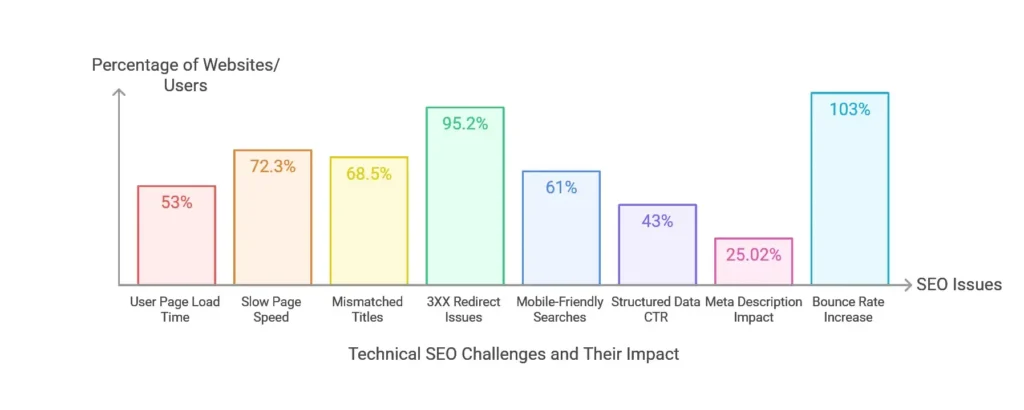
Statistical Facts:
- 53% of users leave the page if it takes more than 3 minutes to load. (source)
- 3% of sites have slow pages. (Ahrefs.com)
- 5% of websites have pages and SERP titles that do not match. (Ahrefs.com)
- About 95.2% of sites have 3XX redirect issues. (source)
- About 61% of searches on mobile devices are more likely to contact a business website if their website is mobile-friendly. (source)
- Web pages with structured data are 43% more likely to have a higher CTR than pages with unstructured data. (source)
- The web pages lacking Meta descriptions have a 25.02% lesser chance of ranking higher in search results. (source)
- A webpage delay of more than 3 seconds can increase the bounce rate by 103% (source)
On-page SEO:
On-page SEO, also known as on-site SEO, refers to optimizing a website’s content that is in our control, such as title tags, content, the front page, URL, internal links, etc. Some key strategies can raise a local business’s rankings.
Statistical Facts:
- Websites with user-friendly URL structures have a 35% higher click-through rate CTR than poorly optimized websites. (source)
- The average word count of top-ranking Google articles is around 1800 words. (source)
- Pages that contain videos can attract 41% more organic traffic than web pages that don’t include any videos. (source)
- The presence of a keyword in the URL can increase the click-through rate (CTR) by 45%. (source)
- Internal linking can boost the online presence of a website by 40% (MarketingShepra)
- A webpage containing images relevant to its content can reach a 94% higher audience than web pages without images. (source)
- Web Pages having a load time under 2 seconds have a bounce rate of only 9%. (source)
- Webpages that contain meta-descriptions have a 5.8% higher click-through rate (CTR) than the ones that don’t have any. (source)
- Web pages with structured data are 43% more likely to have a higher CTR than pages with unstructured data. (source)
- One spot increase in rankings can increase CTR by 30.8% (source)
Content marketing and SEO:
Content marketing includes creating, posting, and publishing content that attracts an audience. SEO ensures that the content reaches the maximum audience and ranks higher in search engine results.
Statistical Facts:
- The content marketing revenue will be around $107 billion by 2026. (source)
- 69% of marketers actively invested time in SEO in 2021. (source)
- Visual content attracts 43% more audience than just text content. (source)
- 29% of marketers have spent 10-15 hours per week on average creating content (source)
- In 2022, 51% of the accessed content was derived from organic search. (Bright Edge)
- 53% of marketers prioritize blogging as their top content marketing strategy (Optinmonster)
- 56% of marketers have used social media as a means of content promotion in 2024 (Semrush)
- 82% of marketers actively use content marketing, the remaining 10% don’t, and the remaining 8% are unsure whether their company uses content marketing. (source)
- 51% of businesses that invest in content marketing publish content daily. (The manifest.com)
- 70% of the users purchase a product after seeing its advertisement on YouTube. (source)
- 91% of businesses use video as a marketing tool in 2024. (source)
Link building:
Link building is a process in which other websites link to pages on our website to increase their ranking in search engine results (SERPs). Simply, it’s establishing hyperlinks to a website from external websites. According to Google’s 2022 helpful content update, websites with more interlinks that provide high-quality content to their visitors have more chances of ranking higher in SERPs.
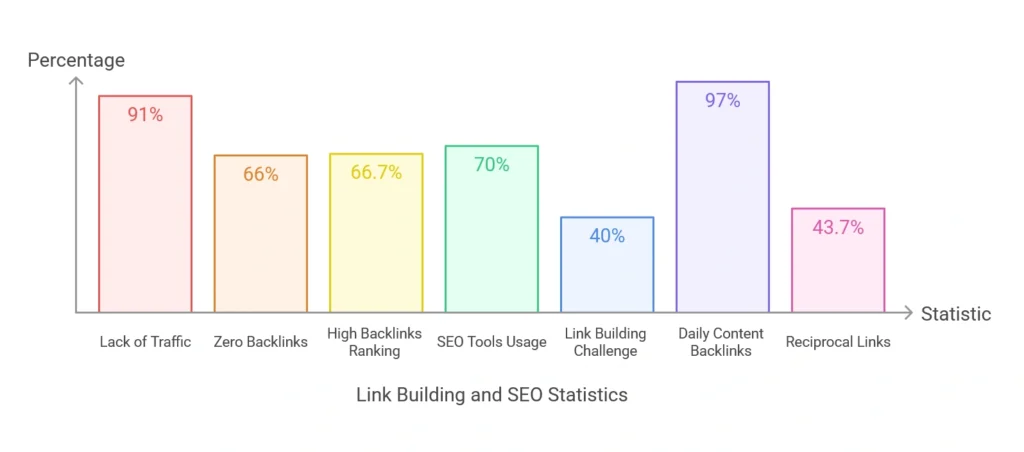
Statistical Facts:
- 91% of webpages fail to get traffic due to a lack of backlinks on their websites. (source)
- Pages with backlinks from reputable websites rank 3.8 times higher than those with fewer or no backlinks. (source)
- In 2025, The average cost of buying a high-quality backlink is $350 per link (source)
- More than 66% of pages have zero backlinks pointing to them(source)
- Websites with more than 10 backlinks on their first page have a 22% higher chance of ranking higher in Google search (source).
- Only 8% of searches are phrased as a question (source)
- About 66.7% of web pages with a high number of backlinks rank within the top 5 positions in search results. (source).
- About 70% of SEO professionals use SEO tools like Ahrefs and Moz to analyze their link-building strategies. (source)
- 40% of marketers consider link building the most challenging aspect of SEO. (source)
- Websites posting content daily generate 97% more backlinks. (source)
- 7% of the top-ranking pages have reciprocal links (Ahrefs.com)
- 2% of all search queries in the US contain three or less than three words. (statista.com)
- Approximately 94% of all blog posts in existence have zero external links (source)
- Around 67.5% of SEO experts used to believe backlinks impact search rankings, according to this survey (source)
Local SEO:
Local SEO is a search engine optimization (SEO) strategy that helps businesses be more visible in local search results on Google. Some businesses only want to get a good amount of traffic from the cities they serve, so we used local SEO to help these types of businesses.
Statistical Facts:
- 30% of mobile searches are location-based (source).
- 78% of location-based mobile searches result in a product purchase or a business visit within 24 hours (source).
- 42% of the people who have searched for a local search click on Google Maps results. (source).
- 60% of people who search for a local business directly contact them using the search results. E.g., click on call. (source)
- In 2024, 97% of users searched for a local business. (source).
- 25% of small business websites don’t have an H1 tag (Fresh Chalk)
- 62% of users ignore a business if it doesn’t have a website. (source).
- In 2023 and 2024, the searches containing the phrases “near me” or “close by” saw a 900% increase (source).
- 29% of all Google SERPs contain a local pack in results. (source)
- 84% of “near me” searches are on mobile (source)
- An average local business receives around 1200 monthly views on their Google business profile. (source).
- 58% of users use voice search to find a local business (source)
- Local mobile searches are growing 50 times faster than overall mobile searches. (source)
- 87% of customers use Google to evaluate or see the reputation of a local business. (source)
- “Near me” searches have increased by more than 500% percent (source)
Mobile search:
Mobile devices have become a basic human need, as important as morning coffee in modern life. Every business also needs to optimize its websites or apps for mobile devices. “Orienting your digital content, like websites or apps, for mobile devices is known as mobile optimization.”
For example, it is important to note that it seems good on every device when we visit Amazon on our laptops, tablets, or mobile devices. This is because of the company’s mobile optimization, which allows their site to have seamless functionality and UX across platforms.
Statistical Facts:
- 3% of internet users access the internet using mobile phones. (BrowserStack.com)
- 96% of mobile internet users are 16-64 of age. (source)
- About 55% of website traffic comes from mobile devices. (source)
- 84% of “near me” searches are on mobile (source)
- 30% of mobile searches are location-based (source).
- 78% of location-based mobile searches result in a product purchase or a business visit within 24 hours (source).
- Local mobile searches are growing 50 times faster than overall mobile searches. (source)
- Google holds about 93.68 percent of the mobile search engine market (source).
- 63% of Google searches are done on mobile, according to reports in 2024 (source).
- According to a survey in 2022, only 0.78% of Google searches go to the second page and click on something. (source)
- 55% of e-commerce revenue will come from mobile transactions in 2025. (source)
- Mobile pages with a faster loading speed have about a 27% increase in conversion rate. (source).
- Organic CTR on mobile is 50% less than that of desktop (source)
- 87% of smartphone owners use a search engine daily. (Go-Globe)
- 60% of mobile users are likely to click on the first two to three search results they see. (onthemap.com)
- Users purchased 8.9 million health and beauty items between the year 2019 and 2021
- Mobile users answer around 8 billion queries each month on Google lense (google)
E-commerce SEO:
E-commerce SEO is optimizing an online store to increase its ranking in search engine results. It includes optimizing product and category pages and other aspects like mobile responsiveness and site speed.
Statistical Facts:
- 55% of e-commerce revenue will come from mobile transactions in 2025. (source)
- Almost 70% of consumers directly go to the search bar when they land on an e-commerce store (source)
- 43% of all e-commerce traffic comes from Google’s organic search. (source)
- 5% of all traffic to e-commerce sites comes from search engines. (rebootonline.com)
- 61% of visitors in the United States purchase a product based on recommendations from a blog. (source)
- com was the most visited e-commerce site in the world in 2024 (semrush.com)
- The e-commerce websites that load within 2 seconds have 15% higher conversion rates for e-commerce purchases. (source)
- The e-commerce websites with video content on the product page have a 37% higher conversion rate. (source).
- E-commerce sites with high-quality images of products on product pages increase sales by 40% (source).
- An e-commerce website can attract 70% more traffic if optimized for long-tail keywords. (source).
- $497.16 is the average amount U.S. small businesses spend on SEO services per month(backlinko.com)
Social Media & SEO:
Social Media SEO means optimizing our social profiles to attract more audiences through search. It’s different for every social media platform, but the goal is the same. Social media isn’t only a place to connect with friends only now. Now, it’s a connection spot between businesses and customers.
Statistical Facts:
- According to a survey conducted in January 2024 involving 1528 social media marketers, about 42% of respondents agreed that people now prefer to find brands on social media platforms instead of search engines, and 82% said that they would choose social media over a brand’s website (source).
- Articles shared on social media platforms like Twitter and Facebook receive 22% more backlinks. (source)
- Posts with images attract 2.3 times more audience, which results in a higher click-through rate (CTR) for websites (source).
- 50% of businesses will integrate social media with SEO strategies in 2025 to enhance their content reach and attract more audiences (source).
- LinkedIn blog posts have a 30% higher click-through rate to company websites as compared to other social media platforms (source)
- After social media, a website is one of the most popular marketing channels. (source)
- 13% of business social media accounts are managed by owners of the business (searchlogistics.com)
- 81% of marketers have integrated their social networks with e-commerce systems in 2024. (source)
- 64% of marketers have used social media to build brand awareness in 2024. (source)
- About 80% of online buyers have purchased from social media ads in 2024. (source)
- Facebook is the most popular social media platform, and it is used by 94% of B2B and B2C marketers. (source)
AI & Machine Learning in SEO:
Artificial intelligence and machine learning can also be used in SEO to improve search engine rankings. Artificial intelligence tools can analyze a website’s structure, content, and other aspects, determine any technical issues, and track keyword performance. Moreover, machine learning can automate specific SEO tasks.
Statistical Facts:
- Globally, 35% of companies use Artificial intelligence to optimize their websites. (source)
- Google uses over 200 factors in their algorithm for ranking websites (source)
- 42% of companies have planned to use artificial intelligence in the future. (source)
- More than 80% of marketers worldwide integrate some form of artificial intelligence into their online marketing activities. (source).
- Around 57% of B2B marketers in the United States use chatbots in their demand generation programs to understand their audience and for data analysis (source).
- 47% of marketers based in the United States, the United Kingdom, India, and Canada use trust AI with ad targeting (source).
- 48% of marketers use AI tools for keyword research and to analyze the recent trends in the market. (source)
- The meta tags and descriptions optimized through AI have an improved click-through rate of 21%. (source)
- According to the statistics, the AI market is expected to grow at a compound annual growth rate (CAGR) of 28.46% from 2024 to 2030 (coolest-gadget.com).
- 60% of search engines use AI-based ranking signals to measure a website’s content quality (source).
- 75% of consumers trust content written by generative AI (source)
Industry-Specific SEO Statistics:
Industry-specific SEO focuses on improving strategies to address the challenges of different sectors. Businesses in healthcare, e-commerce, finance, etc., can enhance their online presence by understanding their audience’s search behavior.
Statistical Facts :
- 43% of all e-commerce traffic comes from Google’s organic search. (source)
- 14% of United States small businesses spend over $5000 yearly on SEO services. (source)
- E-commerce sites have a return on advertising spend (ROAS) of 3.65 and an ROI of 317% (source)
- Biotech companies benefit significantly from SEO, with an ROAS of 9.20 and an ROI of 788%. (source)
- Technology companies focusing on long-tail keywords have a 37% increase in organic conversions. (Backlinko)
- $361 is the average cost to purchase a backlink (source)
- Almost 46% of marketers agree that SEO leads to success in content marketing (source)
- Hotels with GMB profiles have a 58% increase in direct bookings. (source)
- 69% of marketers spent money on SEO in 2021. (source)
Impact of these SEO facts on your ROI
Return on investment (ROI) is a measure used to evaluate the profitability of an investment. It means analyzing whether the amount of money a business gets in return for investing has increased. One can determine whether their SEO strategies are worth the investment by knowing these facts about SEO.
In 2025, these 150 SEO marketing statistics will help businesses make decisions. It’s essential to know the difference between an organic vs. paid search. An organic search receives 5.6 times higher ROI than a paid one.
As the search engine optimization landscape continuously evolves, statistics on SEO will also change. We can expect to see several SEO trends in 2025. Most significant of these is AI overviews.
AI overviews
One of the greatest impacts is the Ai AI-generated answers that Google and some other search engines display directly when a person searches a query. Since they provide direct answers, fewer people click on the organic results, leading to zero-click searches and causing less traffic to the websites. So, to cater to it, individuals should focus on extensive content, and the person has to study it in detail to understand it.
Again, your focus should be on creating top-of-funnel content, demonstrating E-E-A-T (expertise, experience, authoritativeness, and trustworthiness).

